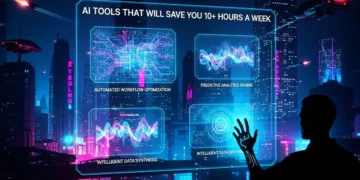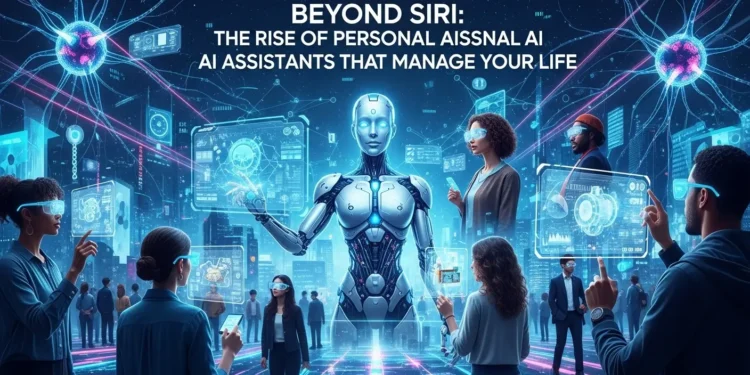Remember when asking your phone for the weather felt like magic? That was just the beginning. Today’s AI personal assistants are evolving from simple command-takers into proactive, cognitive partners that manage our digital lives, anticipate our needs, and boost our productivity to unprecedented levels .
Gone are the days of rigid, robotic voice commands. The next generation of AI assistants leverages cutting-edge technologies like natural language processing and machine learning to understand context, learn from your habits, and execute complex workflows across your apps and devices . Imagine a future where your personal AI doesn’t just respond to your requests but anticipates your needs before you even express them. This is the new frontier of artificial intelligence in our daily lives.
Are you ready to discover how these intelligent companions can transform the way you work and live?
What Is an AI Personal Assistant? More Than Just a Voice in a Speaker
At its core, an AI personal assistant is sophisticated software designed to perform tasks and provide services for you. Unlike the static chatbots of the past, these assistants use artificial intelligence, specifically natural language processing (NLP) and machine learning, to understand and respond to voice or text commands in a human-like way .
But what truly sets a modern AI assistant apart is its ability to learn and adapt. It’s not just about following orders; it’s about understanding your preferences and routines. Through continuous interaction, these systems improve their accuracy and become more attuned to your unique style, offering a truly personalized experience . Think of it as hiring an executive assistant who learns your work style inside and out, handles your digital busywork, and is available 24/7, all at a fraction of the cost .
The key differentiator from earlier models is deep system integration. Modern AI personal assistants don’t operate in a vacuum. They connect with your calendar, email, smart home devices, and other apps, creating a seamless and unified digital experience . This allows them to see the full picture of your life and provide assistance that is both context-aware and genuinely helpful.
The Evolution of AI Assistants: From Simple Commands to Anticipatory Companions
The journey of AI assistants began with rudimentary chatbots like ELIZA in the 1960s, but it wasn’t until the 2010s that they became household names with the introduction of Apple’s Siri, Amazon’s Alexa, and Google Assistant . These early assistants were revolutionary, but they were largely reactive—they only acted when spoken to.
Today, we are witnessing a monumental shift. The future of AI-powered personal assistants lies in anticipatory AI . This advanced form of assistance uses machine learning models to analyze patterns in your behavior, preferences, and routines. By understanding these patterns, the AI can predict what you might need next and offer proactive solutions.
How Anticipatory AI Works in Practice
Imagine your assistant analyzing your calendar, current location, and real-time traffic data. Before you even think to check, it might notify you: “You have a meeting across town in 45 minutes. With current traffic, I suggest you leave now to arrive on time” . This isn’t science fiction; features like this are already being implemented.
A study by Stanford University found that anticipatory AI can increase productivity by up to 30% by reducing the time spent on decision-making and planning . Furthermore, a report by McKinsey suggests that the adoption of such technology could lead to a $1 trillion increase in global productivity by 2030 . The economic and personal efficiency gains are staggering.
What would you do with an extra 30% of your productive time back?
Key Features of a Modern AI Personal Assistant
So, what should you look for in a powerful AI personal assistant in 2025? The capabilities have expanded far beyond setting timers. Here are the core features that define a top-tier assistant today:
Natural Conversation: Early assistants required specific, rigid commands. Today’s AI assistants understand natural, casual language, allowing you to speak to them as you would to a human colleague .
Generative Capabilities: This is a game-changer. Your assistant can now create polished content. Need to respond to an email? It can draft a professional response in your voice. Preparing for a presentation? It can transform your bullet points into compelling slides .
Task Automation: This is where AI assistants save you real time. They can automate repetitive tasks like scheduling meetings, filtering and prioritizing emails, and even gathering information from the web or your documents .
Seamless System Integration: A true assistant acts as a central hub. It should integrate deeply with your existing tools—your CRM, project management software, smart home devices, and communication platforms—to create a frictionless workflow .
24/7 Availability and Multilingual Support: Unlike human assistants, AI is always on. This is crucial for customer support and for users who operate in different time zones or languages. The best assistants can handle interactions in multiple languages, breaking down communication barriers .
The Top AI Personal Assistants Shaping the Market in 2025
The landscape of AI assistants is diverse, with different tools optimized for different tasks. Here’s a look at some of the leading options available today
| AI Assistant | Best For | Key Strengths | Considerations |
|---|---|---|---|
| Amazon Alexa | Smart home control & routines | Vast “Skills” library, deep smart home integration, versatile hardware lineup | Steep learning curve due to extensive features |
| Google Assistant/Gemini | Google Workspace users & quick answers | Powerful search, excellent contextual understanding, strong anticipatory features | Limited outside the Google ecosystem |
| Apple Siri | Deep integration with Apple ecosystem | Handles app actions (messages, reminders) effortlessly, strong privacy focus | Less effective outside Apple devices, lacks advanced conversational context |
| ChatGPT | Creative tasks, ideation, & complex problem-solving | Versatile content creation, powerful reasoning abilities, extensive plugin ecosystem | No direct app integration, acts more as a chatbot than an integrated assistant |
| Pieces | Privacy-first developer workflows | Local, private operation; acts as a “second brain” with long-term memory for projects | Requires local setup, newer to the market |
| Otter AI | Business meetings & transcription | Accurately transcribes, summarizes, and generates action items from meetings | Accuracy can drop with accents or background noise |
As you can see, there isn’t a single “best” assistant for everyone. The right choice depends entirely on your existing ecosystem, workflow, and priorities. Do you value deep smart home control, seamless app integration, or creative brainstorming above all else?
The Technology Behind the Magic: NLP and Machine Learning
The seamless interaction we experience with AI assistants is powered by two fundamental technologies: Natural Language Processing (NLP) and Machine Learning (ML).
Natural Language Processing is the component that allows the assistant to understand human language. It goes beyond simple keyword matching. NLP uses techniques like text analysis and sentiment analysis to comprehend your queries, extract their meaning, and generate contextually relevant responses . This is what enables you to speak naturally to your assistant, using casual phrases and complex sentences.
Machine Learning, on the other hand, is the engine of adaptation. It’s a branch of artificial intelligence that allows algorithms to learn from data without being explicitly programmed . Every interaction you have with your assistant is a data point. ML algorithms analyze these interactions, identify patterns in your behavior, and use this information to improve performance and personalize future responses . This is how your assistant learns that you prefer morning briefings, or that you always ask for a traffic update on your way to work.
Together, NLP and ML transform a simple program into an intelligent, evolving personal AI that becomes more useful and attuned to you every day .
Implementing Your AI Assistant: A Strategy for Success
Adopting a powerful AI assistant isn’t about flipping a switch. To get the most value, a strategic approach is key. Diving in without a plan can lead to frustration. Here’s how to ensure a successful implementation :
Identify Your Biggest Time Sinks: Start by auditing your workweek. What repetitive tasks consume a disproportionate amount of your time? Is it scheduling meetings, managing your inbox, or searching for information across apps? Document these pain points—they are your implementation roadmap.
Set Clear Boundaries (The Green-Yellow-Red Framework): Not every task should be delegated to AI. Create a simple framework:
Green Zone: Tasks your AI can handle independently (e.g., scheduling, data gathering).
Yellow Zone: Tasks requiring an AI draft with your final approval (e.g., email responses, meeting summaries).
Red Zone: Tasks that must remain exclusively human (e.g., sensitive negotiations, personal relationships, critical decisions).
Start Small and Scale Over Time: Don’t try to automate everything at once. Pick one pain point—like inbox management—and master the assistant’s features for that specific use case. Once you’re comfortable, move on to the next workflow. This gradual adoption minimizes mistakes and builds your confidence.
Measure Your Success: Track both quantitative and qualitative improvements. How much time have you reclaimed? Has the quality of work improved? Do you feel less cognitive load? Regularly reviewing these metrics will help you refine your approach and demonstrate the return on investment.
Have you identified the single biggest digital friction point in your day that an AI could solve?
The Real-World Impact: Advantages and Considerations
Embracing a personal AI assistant offers powerful benefits, but it’s important to be aware of the potential drawbacks.
The Bright Side: Key Benefits
Efficiency and Time-Saving: By automating repetitive tasks, assistants free you up to focus on high-impact activities, dramatically boosting productivity.
Personalization and Context: The AI learns your habits and preferences to provide tailored recommendations and anticipate your needs.
24/7 Availability: Unlike a human assistant, your AI partner is always on and ready to help, regardless of time or day.
Enhanced Accessibility: Features like voice control and text-to-speech empower users with disabilities, fostering greater independence.
The Caveats: What to Watch Out For
Privacy Concerns: These assistants require access to your personal data. It is crucial to review privacy policies and use tools with strong security features .
Dependence on Connectivity: Most assistants need an internet connection to function, which can be a limitation in areas with poor service .
Potential for Over-Reliance: The convenience of AI can risk dulling critical thinking and problem-solving skills if not balanced with manual effort .
The Future of AI Assistants: From Tools to Teammates
The evolution of AI personal assistants is accelerating, and the future looks even more integrated into our lives. We are moving from a paradigm of tools that respond to commands to one of proactive teammates that operate with increasing autonomy .
Key trends to watch include:
Increased Autonomous Agency: Future assistants will be able to automate complex, multi-step workflows. Imagine an AI that can research vacation options across multiple travel sites, present optimized itineraries based on your preferences, and even complete the booking process for you—all without constant supervision .
Enhanced Emotional Intelligence: While still in early stages, emotional AI is a growing field. Future assistants will use sentiment analysis to better detect user emotions from voice tone or word choice and tailor their responses accordingly, offering support or adjusting their communication style . A University of Cambridge study suggested this could improve user satisfaction by 25% .
The Personal AI as a Second Brain: Companies are already working on Personal AI platforms that act as an extension of your own mind. This “second brain” would be trained exclusively on your data, memories, and experiences, allowing it to represent you online, answer questions on your behalf, and manage your personal knowledge in a way no generic assistant ever could .
Privacy and Ethical Considerations: The Balance of Power
With great power comes great responsibility. As AI assistants become more deeply integrated into our lives, they require access to vast amounts of personal data. This raises legitimate concerns about privacy, data security, and the ethical use of artificial intelligence .
A survey by Pew Research found that 60% of AI assistant users are concerned about how their data is being used . High-profile security breaches have highlighted the risks of having a device that is constantly listening in your home .
To address these concerns, it’s crucial to:
Choose assistants from providers who are transparent about their data usage policies.
Utilize privacy features, like voice profiling, which ensures the assistant only responds to authorized users .
Regularly review and manage your data logs and permissions.
The goal is to harness the incredible convenience of AI-powered personal assistants without compromising our fundamental right to privacy. As users and developers, we must collaborate to establish ethical guidelines for the responsible development and use of this transformative technology .
Conclusion: Embracing Your AI Partner
The journey Beyond Siri and Alexa is well underway. The rise of personal AI is not about creating a dystopian future of human replacement, but about empowering ourselves with intelligent tools that handle the mundane, so we can focus on the meaningful.
The modern AI personal assistant is a catalyst for unprecedented efficiency, productivity, and personalization. It’s a partner that learns and grows with you, a teammate that works 24/7, and a central hub that brings order to your digital chaos.
The question is no longer if you should use an AI assistant, but which one you will choose to enhance your life. What will you accomplish when you delegate your digital burdens to a capable, intelligent companion?
FAQs
What is the difference between a chatbot and a personal AI assistant?
While both use AI to communicate, a chatbot is typically designed for a specific function, like answering questions on a website. A personal AI assistant is a broader tool that integrates across multiple platforms to manage a wide range of tasks, from scheduling to workflow automation.
Can these assistants be used for both work and personal life?
Absolutely! Some tools like Motion are built for work productivity, while others like Google Assistant and Siri are excellent for managing personal tasks and smart home devices. The key is to choose one that aligns with your primary needs.
How secure is my data with a personal AI assistant?
Security varies by provider. Apple’s Siri, for instance, emphasizes on-device processing for privacy. Business-focused assistants often offer enterprise-grade security and data residency options. Always check the privacy policy before committing.
Which is the best personal AI assistant for me?
The best assistant depends on your goals. For business automation, consider a specialized platform like Sintra AI. For scheduling, Motion is a strong choice. For general home use within an existing ecosystem, Alexa or Siri are popular fits. (Internal Link: See our guide at geekmetaverse.com/choose-ai-assistant)
What makes the next frontier in personal AI assistants different from current technologies?
The next frontier focuses on emotional intelligence, multifunctionality, and a deeper connection with users.
How can users contribute to the development of AI?
Providing feedback, staying informed, and advocating for responsible AI use are ways users can contribute.
Are there concerns about the impact of AI on privacy?
Yes, as AI becomes more integrated into daily life, privacy concerns are a significant consideration.
What industries are most impacted by the rise of AI?
AI has a transformative impact on various industries, including healthcare, education, finance, and manufacturing.
Will personal AI assistants replace human interaction?
Personal AI assistants are designed to enhance human interaction, not replace it. They aim to simplify tasks and make our lives more convenient.
Can AI assistants understand emotions?
With advancements in emotional recognition and sentiment analysis, AI assistants are becoming more adept at understanding and responding to human emotions.
Are AI assistants a threat to privacy?
Privacy is a valid concern. However, developers are increasingly focusing on building secure and transparent AI systems to protect user data.
How will AI assistants impact industries like customer service?
AI assistants have the potential to streamline customer service by providing faster and more accurate responses, freeing up human agents to handle complex inquiries.
Are there any limitations to AI assistants?
AI assistants still face challenges in accurately understanding complex queries and context. However, ongoing research and development aim to address these limitations.
Remember, the future of personal AI assistants is constantly evolving, and we can expect exciting innovations and advancements in the years to come. These intelligent virtual companions will continue to transform the way we live, work, and interact with technology.
Follow us on our social networks and keep up to date with everything that happens in the Metaverse!
Twitter Linkedin Facebook Telegram Instagram Google NewsAmazon Store





































